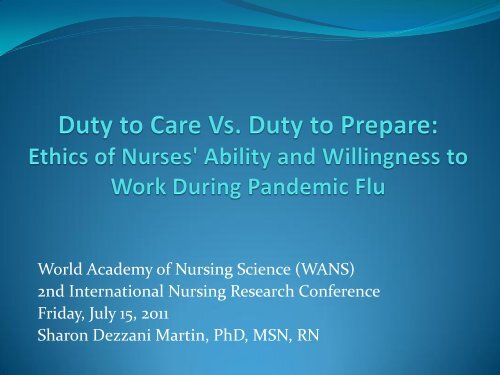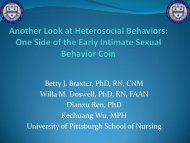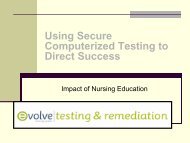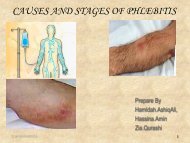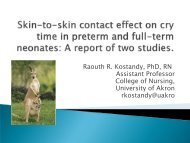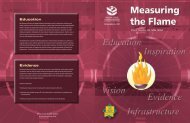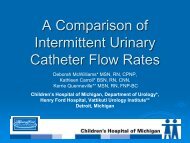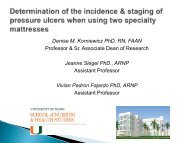Martin, Sharon Dezzani - IUPUI
Martin, Sharon Dezzani - IUPUI
Martin, Sharon Dezzani - IUPUI
Create successful ePaper yourself
Turn your PDF publications into a flip-book with our unique Google optimized e-Paper software.
World Academy of Nursing Science (WANS)<br />
2nd International Nursing Research Conference<br />
Friday, July 15, 2011<br />
<strong>Sharon</strong> <strong>Dezzani</strong> <strong>Martin</strong>, PhD, MSN, RN
Abstract<br />
Aim Explore factors affecting nurses’ ability/willingness to work during pandemic<br />
flu.<br />
Background Studies suggest some nurses may be unable/unwilling to work during<br />
extreme conditions such as PF. Unwillingness is exacerbated by employer<br />
failure to prepare for staff/family safety during emergencies.<br />
Method Questionnaire mailed to random sample of 1,200 Maine nurses during<br />
October - December 2009, second wave of 2009 A/H1N1 flu pandemic.<br />
Results 735 returns. Most (90.1%) reported they would work. Willingness to work<br />
decreased when employers failed to prepare (provide adequate personal<br />
protective equipment (PPE), family/nurse safety, or vaccine/antiviral<br />
medication. Ability to work decreased when nurse was sick, loved one needed<br />
care at home, or with transportation problems.<br />
Conclusion Employer failure to meet ethical duty to prepare impacts nurses<br />
willingness/ability to meet ethical duty to care.<br />
Implications Employers’ duty to prepare precedes and impacts nurses’ duty to care<br />
under extreme conditions.<br />
July 15, 2011 WANS<br />
2
Methods<br />
A cross-sectional design with researcher developed and pilot<br />
tested survey.<br />
Population Nurses registered by Maine State Board of<br />
Nursing (MSBON). Stratified, random sample of 1,200.<br />
Data collection During second wave of H1N1 flu pandemic,<br />
October – December 2009, using voluntary, anonymous<br />
survey via U.S. Postal Service.<br />
Instrument 12 variables testing willingness and 14 variables<br />
testing ability to work.<br />
Data analysis Minitab® 15 for Windows (2006), significance<br />
level p
Findings<br />
• Full sample<br />
• Most (90%) initially willing to work<br />
• ↑ risk resulted in ↓ willingness to work<br />
• PPE & family at risk- willingness<br />
• Family or nurse sick - ability<br />
• Coercive & monetary actions ineffective<br />
• Inappropriate work attendance<br />
• Positive vs. negative responders<br />
• PPE<br />
• Family risk<br />
• Negative responders –fearful/mistrustful, resistant to<br />
incentives<br />
• Focus on retaining positive responders<br />
July 15, 2011 WANS<br />
4
Ethical Implications<br />
Nurses must engage in dialog and demonstrate leadership in<br />
public and political determinations of “duty to provide care<br />
with obligations to their own health and that of their<br />
families during disasters, pandemics, and extreme<br />
emergencies.” (p.5, Nursing’s Social Policy Statement, 2010)<br />
To date there has been inadequate dialog regarding nurses’<br />
duty to care in emergencies and little or no dialog regarding<br />
employer’s duty to prepare for emergencies.<br />
July 15, 2011 WANS 5
Ethical Implications<br />
Though caring for others is central to the practice of nursing,<br />
the nurse must also promote self-care as well as care of<br />
environment and society. (p. 4, Nursing Scope and<br />
Standards of Practice, 2010)<br />
This includes the requirement of adequate safety precautions<br />
during emergencies and the expectation of employer<br />
preparedness even when that involves financial sacrifice for<br />
the employer.<br />
July 15, 2011 WANS 6
Ethical Implications<br />
Studies have demonstrated the link between healthy<br />
work environment and effective nursing practice.<br />
Unsafe workplace conditions contribute to ineffective<br />
delivery of care and stress among health professionals.<br />
(p. 5, Nursing Scope and Standards of Practice, 2010)<br />
Unsafe conditions can include the failure to provide<br />
adequate PPE, vaccine, immunizations, education, or<br />
family safety measures during pandemic flu.<br />
July 15, 2011 WANS 7
Ethical Implications<br />
The nurse owes the same duties to self as to others, including<br />
the responsibility to preserve integrity and safety…<br />
(Provision 5, Code of Ethics for Nurses, 2010).<br />
This can include a moral objection to resist an employer<br />
pattern of behavior that endangers patient and staff wellbeing,<br />
such as failure to prepare adequately for extreme<br />
emergencies.<br />
July 15, 2011 WANS 8
Ethical Implications<br />
The nurse participates in establishing, maintaining, and<br />
improving healthcare environments and conditions of<br />
employment conducive to the provision of quality health<br />
care...(Provision 6, Code of Ethics for Nurses, 2010).<br />
Conflicting obligations for the nurse (employer, family, and<br />
society) are common. Paramount is the employer’s duty to<br />
prepare in order to provide the nurse with a safe workplace<br />
for self and family. This in turn improves the quality of<br />
healthcare for the patient.<br />
July 15, 2011 WANS 9
July 15, 2011 WANS<br />
10
July 15, 2011 WANS<br />
11
July 15, 2011 WANS<br />
12
July 15, 2011 WANS<br />
13
July 15, 2011 WANS<br />
14
July 15, 2011 WANS<br />
15
July 15, 2011 WANS<br />
16
July 15, 2011 WANS<br />
17
July 15, 2011 WANS<br />
18
July 15, 2011 WANS<br />
19
July 15, 2011 WANS<br />
20
Minimal racial, ethnic, gender diversity among study<br />
population<br />
Potential non-response bias<br />
Study power (76%)<br />
Discrepancy between respondents’ stated intentions -<br />
actual behavior & overestimation of willingness to<br />
behave in socially desirable behavior<br />
July 15, 2011 WANS 21
1.Ajzen I, Brown T, Carvajal F. Explaining the discrepancy between intentions and actions: the case of hypothetical<br />
bias in contingent valuation. Pers Soc Psychol Bull. 2004:30:1108-1121.<br />
2.Dillman D, Smyth J, Christian L. Internet, Mail, and Mixed-Mode Surveys: The Tailored Design Method. Hoboken,<br />
New Jersey: John Wiley & Sons; 2009.<br />
3.Ives J, Greenfield S, Parry J. et al. Healthcare workers' attitudes to working during pandemic influenza: a qualitative<br />
study. BMC Public Health. 2009;9:56.<br />
4.Lindner J, Murphy T, Briers G. Handling nonresponse in social science research. J Agric Educ. 2001:42:43-53.<br />
5.Loewenstein, G. F., Weber, E. U., Hsee, C. K., & Welch, N. (2001). Risk as feelings. Psychological Bulletin, 127(2), 267-<br />
286.<br />
6.Qureshi K, Merrill J, Gershon R. et al. Emergency preparedness training for public health nurses: a pilot study. J<br />
Urban Health. 2002;79:413-416.<br />
7.Qureshi K, Gershon R, Sherman M. et al. Health care worker's ability and willingness to report to duty during<br />
catastrophic disasters. J Urban Health. 2005;82:378-388.<br />
July 15, 2011 WANS 22
smartin@sjcme.edu<br />
Saint Joseph’s College of Maine<br />
July 15, 2011 WANS 23


